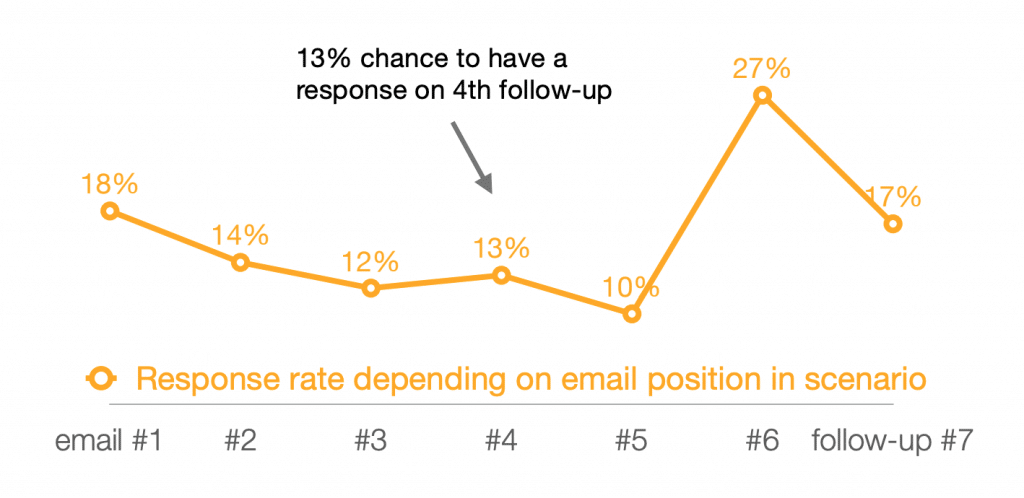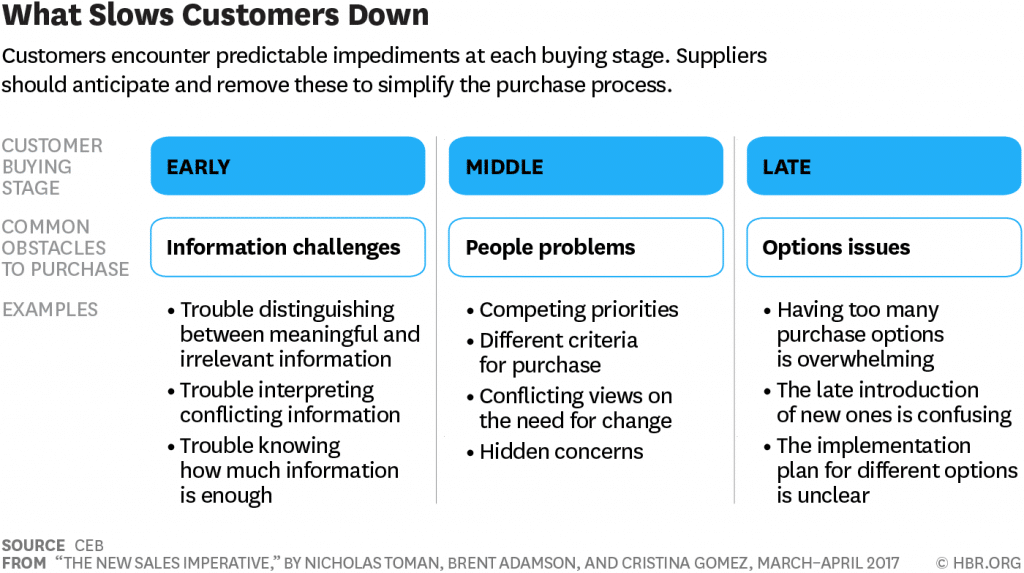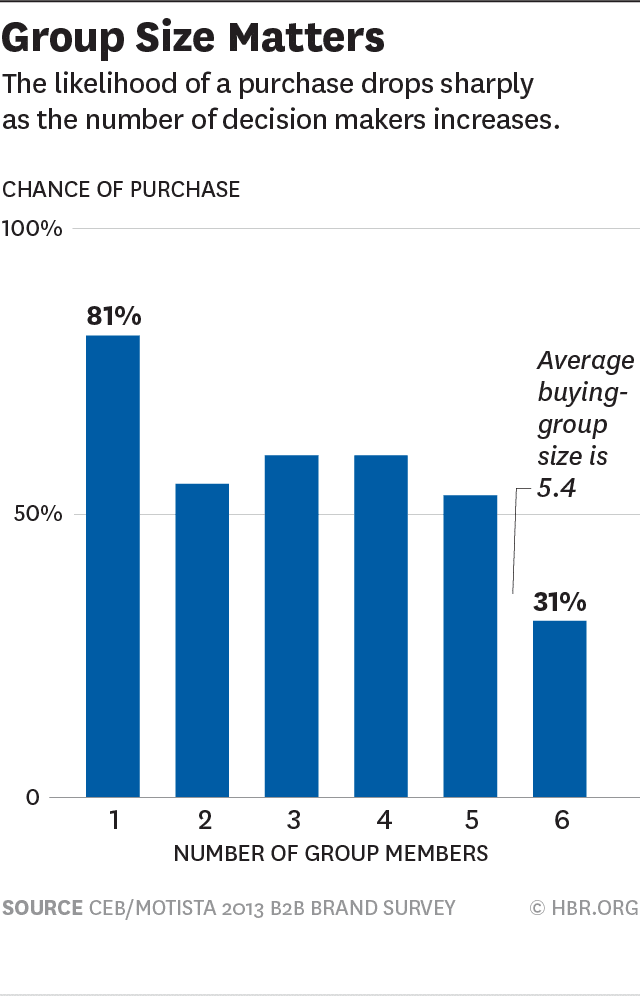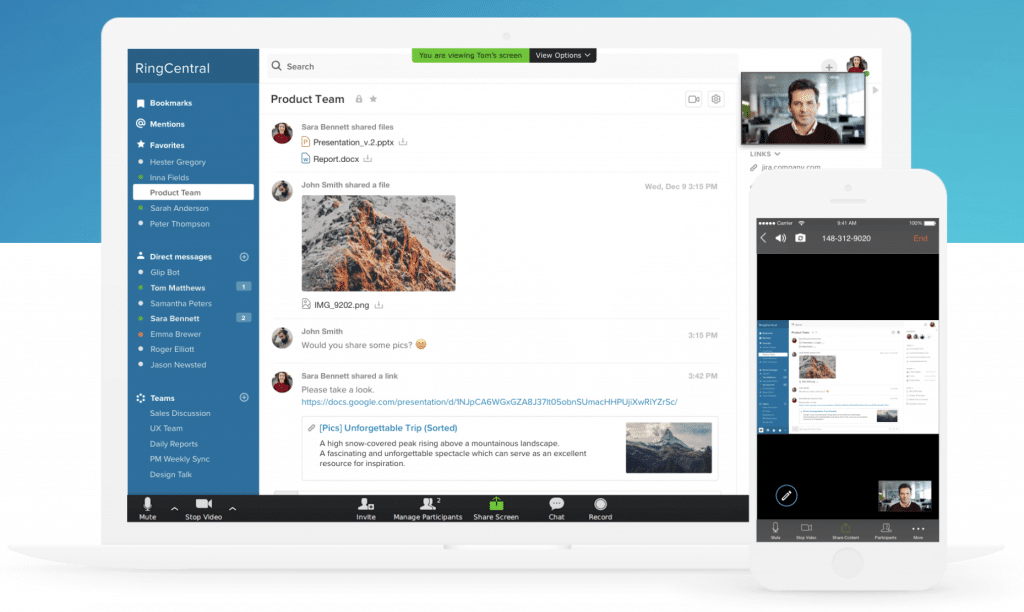Sales follow-ups can be intimidating. First, there’s the question of what to put in them and how not to come across as spammy. And then there’s the punishing silence if you don’t get a response.
After two or three follow-ups, it’s natural to start panicking a little and wonder if you need a career change—but we have good news for you.
Data shows it can actually take up to six follow-up emails for a prospect to respond favorably after initial contact1.

So… there’s hope.
But six is a pretty challenging number, especially if you’re dealing with hundreds of leads.
But it’s simple: if you don’t follow up, you won’t hit targets.
In this post, we’ll break it all down for you. We’ll cover:
- What a “good” sales follow-up email is
- The anatomy of a sales follow-up email
- 3 things you can do right now to boost your follow-up success rate
- 8 sales follow-up email templates for different situations—and tips on how to use each one
Start closing more deals. Grab the free outbound sales playbook.
What is a “good” sales follow-up email?
First off, a follow-up email is an email you send after your first contact with a prospect. (Your first contact could be over email itself—or you might’ve met them at an event or over a cold call.)
This follow-up email’s purpose is to help you stay in your prospect’s memory while gently nudging them towards a buying decision (or a favorable response).
Now, a good sales follow-up email should do a few things well:
- Get inside the head of the prospect and answer their ongoing insecurities
- Refrain from overwhelming them with too many choices
- Understand where the prospect is at in their buyer journey, anticipate their needs in advance, and if possible, address them.
Here’s a handy visual from Harvard Business Review that outlines what holds prospects back at every stage of their journey. It’s a good guide especially for business-to-business sales. Keep this in mind while deciding what would add value for your prospect in your sales follow-up email:

Source: Harvard Business Review
The anatomy of a sales follow-up email
Remember, no two follow-ups are the same. The content of sales follow-up emails should differ based on the situation–where the prospect is at in their journey, or how many follow-ups you’ve done–but the basic structure to a winning email is pretty much the same:
1. A good subject line
A quick glance at the subject line is enough to tell a prospect if the email is worth their time. And an email that gets opened is an email that gets read.
3 tips for a high-converting subject line
- Keep your headlines short and interesting—and then A/B test them. There’s a lot of conflicting information about what the “perfect” headline length is, but the data seldom reveals the context. Some say the best length is seven words while others say the longer the better. Do these rules apply to your segment and industry? Only A/B testing with multiple variations of the subject line can help. See which of your subject lines have the best open rates.
- Optimize your subject line for mobile. While fixing your headline length, bear in mind the most commonly used devices in your segment. An iPhone shows up to 41 characters in portrait mode, while an Android shows between 27 and 30.
- Personalize your subject line. According to Campaign Monitor, emails with personalized subject lines are 20% more likely to be opened. Do this by using your prospect’s name in the subject or by “flagging” them with a word or phrase that alerts them that this mail is very relevant to them. For example “UX designers: A wireframe in minutes? Possible.”
2. The body
Here’s the thing: your prospects are either low on time, or low on attention (or both). While your headline convinces them that your email is potentially of interest, your body copy proves that it is. Here’s how you can work it:
The body copy six-pack
-
- Start by reminding them of your last communication. Was it face-to-face at an open house? Or was it via email? You don’t have to go into detail. Just reference it.
Check out 11 open house follow-up emails that turn leads into buyers.
- Get to the point quickly. Keep your mail to one paragraph (about 100–150 words) and don’t waste your prospects’ time. Use short, clear sentences and active verbs.
- Provide a value-add. Data shows that 74% of buyers opt to work with the first salesperson to add value. Value-adds can be anything from free downloadable eBooks, to white papers, to case studies and invites, to webinars.
- Personalize your copy as much as possible according to the segment you’re trying to reach. For example, segmented campaigns perform far better than non-segmented campaigns on open, click, and bounce rates.
- Build rapport. At the end of the day, the buyer-seller relationship is still a human-to-human one (no matter how many you’re pursuing at any given time). Ask them how they are, or congratulate them on a new role.
- Cut the trigger words. Don’t use gimmicky, pushy words that create a false sense of urgency like “You’ve been selected!” or “Only three spots left!” These can be annoying at best—and mistaken for spam at worst.
3. Walk away with the CTA
There should always, always be a call-to-action (CTA)—the keyword being “action.” No, not let me know your thoughts. Only clear, actionable directions: click this, fill this out, save your spot here. Give them one option and don’t give them too many distracting things to click.
CTA by CTA, you’ll take baby steps to a “yes.”
3 things you can do right to boost the open rate on your sales follow-up emails
1. Nail the timing
- When businesses follow up with online leads within five minutes, those leads are nine times more likely to convert into customers. So respond quickly if you can!
- Give your prospect at least three days (if not longer) to respond to your first follow-up before you send another one.
- Send your email in the middle of the week and avoid Mondays. Recent research shows that Thursday before 10:30 a.m. is best.
2. Manage your time
Nearly two-thirds (64.8%) of reps’ time goes into non-revenue-generating activities, with sales-related emails taking about 33.2% of their time—and 62.8% of a rep’s time goes into using sales technology, which is frankly a horrific time-suck.
If you don’t need fancy sales apps quite yet, there are two simple tools that can help mitigate this:
-
- A sales playbook arming your reps with call scripts and follow-up email samples saves time by reducing the learning curve for new hires and improves consistency across messaging.
- A communication tool built for sales teams like RingCentral’s mobile app, which:
- Keeps all your relevant information available in one workspace
- Integrates with up to 50 apps (like Salesforce and Zapier) to save time lost in app-switching—which adds up to about 32 days per year, to be exact
- Allows you to video call and instant message with everyone from your prospects to your marketing department at once
3. Switch to team and collaborative selling
In many companies, the decision to buy doesn’t rest with a single person alone—especially when it’s a big ticket purchase. The thing is, your chances of making a sale drops with every additional decision maker involved:

As “buying committees” expand (with 5.4 people now having to formally sign off on each purchase) it’s just not possible for one sales rep to close a deal on their own.
Often, you’d need a colleague’s or manager’s help (which increases the odds of closing by 258%) to win over prospects.
Learn about 8 non-traditional sales management books to read.
Sales can’t work in silos anymore. Why?
- 75% of consumers expect companies to provide a consistent experience wherever they engage with them—whether it’s with sales teams or customer service teams.
- 79% of business buyers say it’s very important to interact with a salesperson as a trusted advisor to their business. A sales rep who is part of a collaborative team is plugged into all the resources they’ll need to be that advisor.
The solution? Collaborative selling. 77% of salespeople say selling collaboratively with other departments is important. This method aligns sales, marketing, and service teams so that each person can understand the insights the others bring to the table—and act on it.
Rather than expecting one person to do it all, why not build a team of specialists who can jump in and rescue a deal at a moment’s notice?
However, for truly effective teamwork to happen, all those different teams need to be able to communicate and collaborate easily. It might be a team chat tool or a video conferencing app. Actually, why not both?

RingCentral’s mobile app lets sales teams have video conferences, send instant messages, do screen shares while on demos, and more—from a computer or any mobile device.
8 sales follow-up email templates for different situations
The first follow-up
Send these follow-ups immediately after your first contact with a prospect. In most scenarios, your prospect is either disinterested or juggling too many options at once. You want to be persuasive, but not too pushy.
Why they’re useful: These follow-ups work because they cut to the chase quickly and succinctly while you’re still fresh in your prospect’s mind.
1. A cold call follow-up email template
Scenario: You’ve had a successful cold call where the prospect has committed to a second sales meeting.
SUBJECT LINE: Scheduling our next meeting on DD-MM at (Time)
Hello (Name),
It was great chatting with you just now. As discussed, I’m sending you a calendar invite for our meeting at (location) and attached the document you requested on the call. You can find more info at (website). Look forward to meeting you soon.
Cheers,
(Name)
(Contact)
Check out 6 sales pitch examples and how to improve your phone, in-person, and email sales pitches.
2. A post-meeting follow-up email sample
Scenario: You’ve had a sales meeting that went well and your prospect said she’d respond in a week. Well, it’s day 9.
SUBJECT LINE: So, what did you think?
Hi (Name),
How are you doing?
Just checking in to see how it’s going at your end. Can I help with anything?
I know (prospect’s colleague) was really concerned about (concern), and I hope we were able to address that. My colleague, (colleague’s name), is an expert on (feature), and I’ll be happy to set up a call if required.
Let me know when it would be a good time to chat.
Regards,
(Name)
(Contact)
3. A trade show follow-up email template
Scenario: You just held an event, like a trade show, where you met a lot of potential customers. Now it’s time to follow up.
SUBJECT LINE: It was great to see you at (Trade Show)
Hi (Name),
It was great meeting you at our booth at (Trade Show). Thanks for stopping by and chatting.
My company is hosting an open house for that property your partner liked, and I’ll be happy to let you in a little earlier so you can look through it before the crowds turn up :).
If you’re interested, just let me know before (date)!
Cheers,
(Name)
(Contact)
4. Warm lead follow-up email
Scenario: Your prospect has downloaded a piece of interactive content on your website, showing that they might be interested in your company.
(Note: Don’t misuse “Re:” to trick your prospect into thinking it’s a real follow-up if it’s the first time you’re contacting them. It’s a trust-basher.)
SUBJECT LINE: Re: Link to the free (asset name) as requested.
Hello (Name),
Thanks for downloading (asset)!
I’d love to know what you thought of it. Were the tips useful? Did you have any questions? Let me know!
(I promise I’m a real human and not a bot!)
Cheers,
(Name)
(Contact)
How to follow up when you didn’t get a response
There are a few common reasons why prospects don’t respond, and here are templates that address each one of them:
5. You’ve got the right person at the wrong time
Scenario: Your prospect was enthusiastic at first, but has missed one or two emails from you.
Why it’s useful: They may not want it now, but they might later. Don’t let a good sales conversation starter go to waste. This email keeps the conversation open.
SUBJECT LINE: What’s next?
Hello (Name),
How are you enjoying (recent milestone you know of)?
I never heard back after our last meeting. I know how crazy things can get over at (prospect’s company) this time of year.
While I really want to work with you to meet (business need) and (benefit), I want to be sure this is something you’re looking for.
If you’re not interested at the moment, just let me know and I’ll take you off my list. If not, I’ll reach out again in a few weeks.
Cheers,
(Name)
(Contact)
6. Wrong person, wrong time
Scenario: You’re hitting a wall with this person on every channel, not just email.
Why it’s useful: It’s straight to the point and concise.
SUBJECT LINE: Am I reaching the wrong person?
Hello (Name),
It’s been a while since I heard from you, so I just wanted to ask…
Am I speaking with the wrong person? If so, it’s all good—could you please put me in touch with the right person?
Cheers,
(Name)
(Contact)
7. Your prospect is simply not interested (Oops)
Scenario: You’ve seen that this prospect has opened your email, but you’re not hearing back.
Why it’s useful: Even if the prospect is not interested, you’ll come away with some useful feedback.
SUBJECT LINE: One question…
Hello (Name),
I hope this email finds you well. I’ve tried reaching you a couple of times via email, and I think I’ve got the wrong person… could you let me know if that’s true?
Please let me know by just responding with a number:
- You’re not looking to resolve (business need) at the moment and I should stop bugging you.
- (Your product/service) doesn’t quite meet your needs.
- You’re still interested but haven’t had the time to get back to me yet.
- I’m speaking to the wrong person.
Thank you!
(Name)
(Contact)
Last-ditch follow-up email
8. Goodbye
Scenario: You’ve followed up more than six times on various channels and you’re taking the hint.
Why it’s useful: Rather than dropping out completely, close the loop so the prospect has a chance to respond if they change their mind.
SUBJECT: (Name), this is it
Hi (Name),
Since I’ve been unable to reach you since our last conversation (on date), I just wanted to let you know that this is the last time I’m reaching out.
No hard feelings though—if this isn’t a priority for you now but might be later, just drop me a line.
Regards,
(Name)
(Contact)
Use these sales follow-up templates wisely
Sales is a numbers game. The more follow-ups you send, the higher your chances of a hit. While there are some basic rules that can increase your open and conversion rate, the X factor is you.
Use these templates as a guide, but inject your own unique voice and personality to connect with your prospect. Now that you have a few templates to work with and know the ins and outs of effective sales follow-ups, how will you follow up on your next prospect?
1go.iko-system.com/rs/953-WQA-857/images/800k_sales_emails-ebook-final.pdf
Originally published Mar 15, 2020, updated Jun 19, 2024





